Connecting the Mediterranean Sea with the Atlantic Ocean between the southern tip of Spain and northern Africa, the Strait of Gibraltar hosts a spectacular range of marine life. This channel, created roughly 5.33 million years ago from the Zanclean flood, measures 36 miles long, with a minimum width of approximately 8 miles.
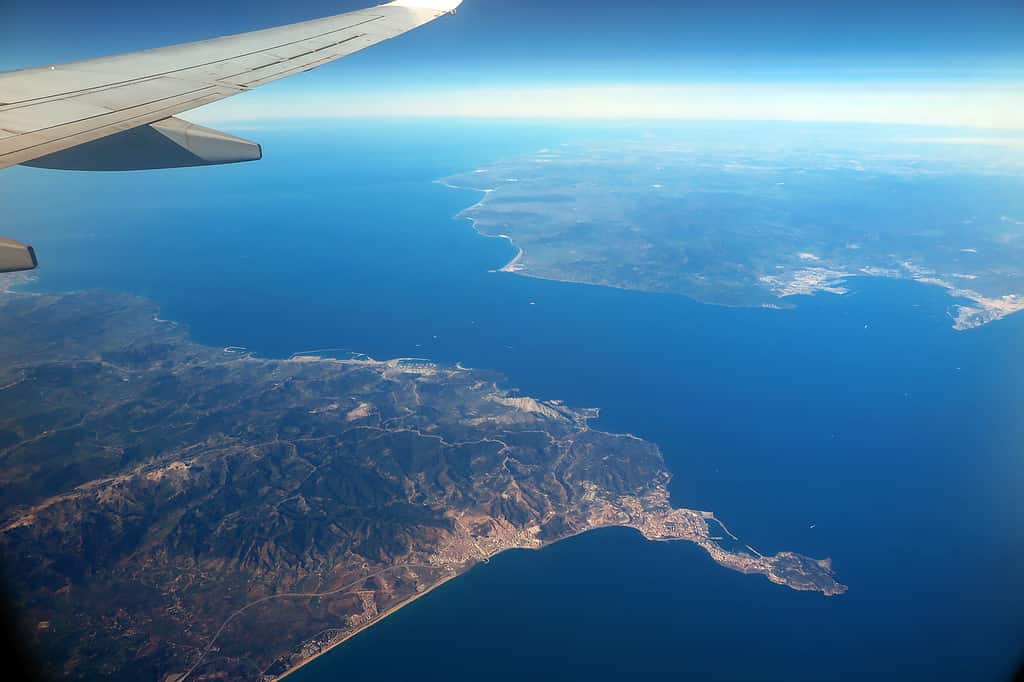
The Strait of Gibraltar, connecting the Mediterranean Sea and the Atlantic Ocean, supports an incredible diversity of marine life.
©Raphael Comber/iStock via Getty Images
So, what lives in the Strait of Gibraltar, and is it safe to swim in this body of water? With an average depth of 1,200 feet, this strait offers prime habitat along multiple sections of the oceanic water column for a range of subtropical marine animals. In this guide, we’ll talk about six incredible species that are permanent or nomadic residents of the Strait of Gibraltar and offer our informed opinion about the safety of swimming.
Read on to learn more.
What Lives in the Strait of Gibraltar: Striped Dolphin (Stenella coeruleoalba)
Globally distributed in warm-temperate and tropical waters, the pelagic striped dolphin is most abundant in the Strait of Gibraltar in the summer months. As its common name implies, the striped dolphin features lovely light and dark grey bands and streaks along its sleek frame. This species can measure up to 9 feet in length and can reach up to 350 pounds. They are highly social dolphins and typically live in cohesive groups of 25-100 individuals. They hunt at various depths along the water column. These dolphins are capable of diving up to 2,100 feet to capture deep-sea animals. such as lanternfish. Their varied diet includes fish, squid, octopus, krill, and crustaceans.
The Strait of Gibraltar is a birthing ground for the striped dolphin. Typically, researchers document the most newborn calves in this body of water in August.
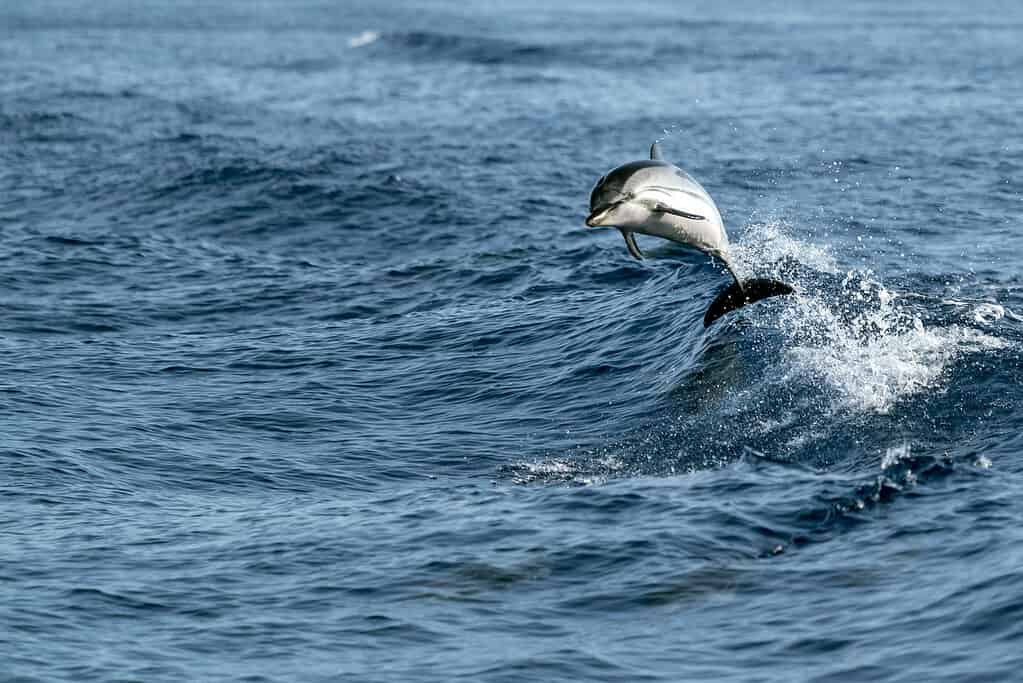
The best time to see striped dolphins pass through the Strait of Gibraltar is during the summer months.
©izanbar/iStock via Getty Images
Orcas (Orcinus orca)
Every July and August, a subpopulation of 40 orcas (Orcinus orca) pass through the Strait of Gibraltar. This family of orcas is critically endangered, according to the International Union for the Conservation of Nature. In recent years, individuals from this pod have become famous for ramming boats passing through the strait.
Currently, at least 15 orcas in the pod are participating in the vessel ramming. The attacks are directed primarily at the rudders of sailboats. To date, the orcas have damaged about 250 boats and caused four to sink. Some orca scientists theorize that the highly social and intelligent orcas may be acting defensively after their family member was traumatically harmed by the vessel strike. In a 2022 study on this phenomenon, researchers theorized that the behavior may originate from trauma endured by a female orca named White Gladis after she was injured in a vessel strike in 2020. Other theories for the boat attack motives include play and coordinated group learning activities. Ultimately, this new behavior by orcas passing through the Strait of Gibraltar emphasizes the need to deeply consider the effects of human maritime activities on marine life.
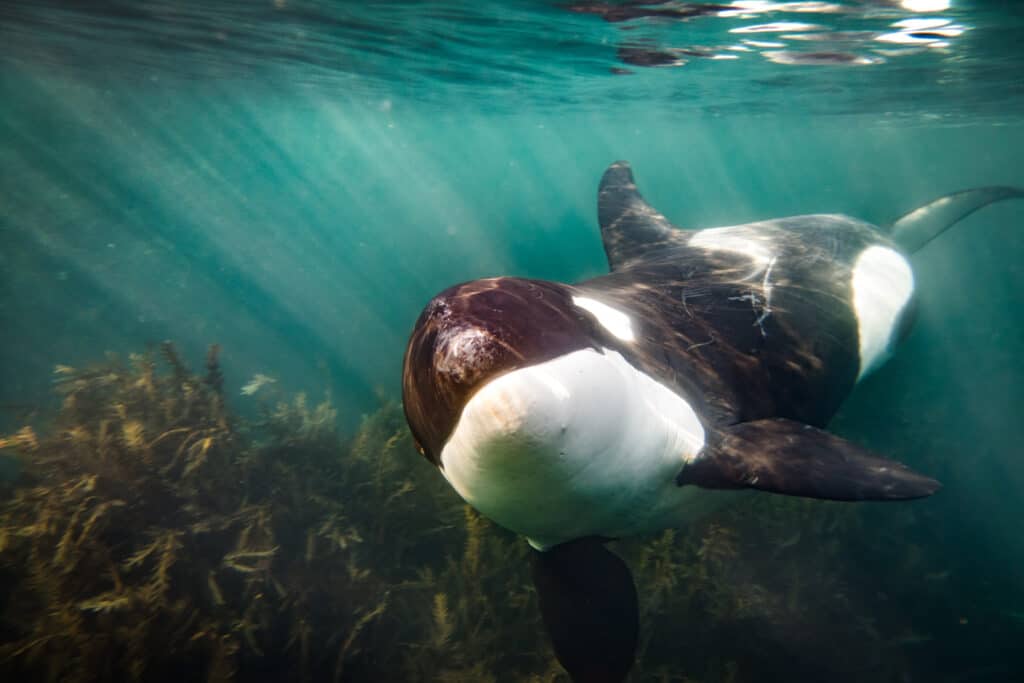
A subpopulation of orcas, that includes about 40 individuals, regularly passes through the Strait of Gibraltar.
©Nick Grobler/Shutterstock.com
What Lives in the Strait of Gibraltar: Loggerhead Sea Turtle (Caretta caretta)
The most common species of sea turtle to pass through the Strait of Gibraltar is the loggerhead (Caretta caretta). This strait acts as an important migratory channel for Atlantic and Mediterranean loggerhead populations.
One 2007 study found that a strong and ever-present eastward current at the Strait of Gibraltar may trap small, juvenile Atlantic loggerhead sea turtles inside the western Mediterranean Sea. They remain until they are strong enough to swim back against the current. Once these juvenile turtles become skilled enough in counter-current swimming and diving, they migrate westward through the Strait of Gibraltar, often heading back to their coastal, natal home waters.
Loggerhead sea turtles are primarily carnivorous. In coastal waters, such as the Strait of Gibraltar, they feed primarily on bottom-dwelling invertebrates. This diet includes mollusks, horseshoe crabs, and true crabs.
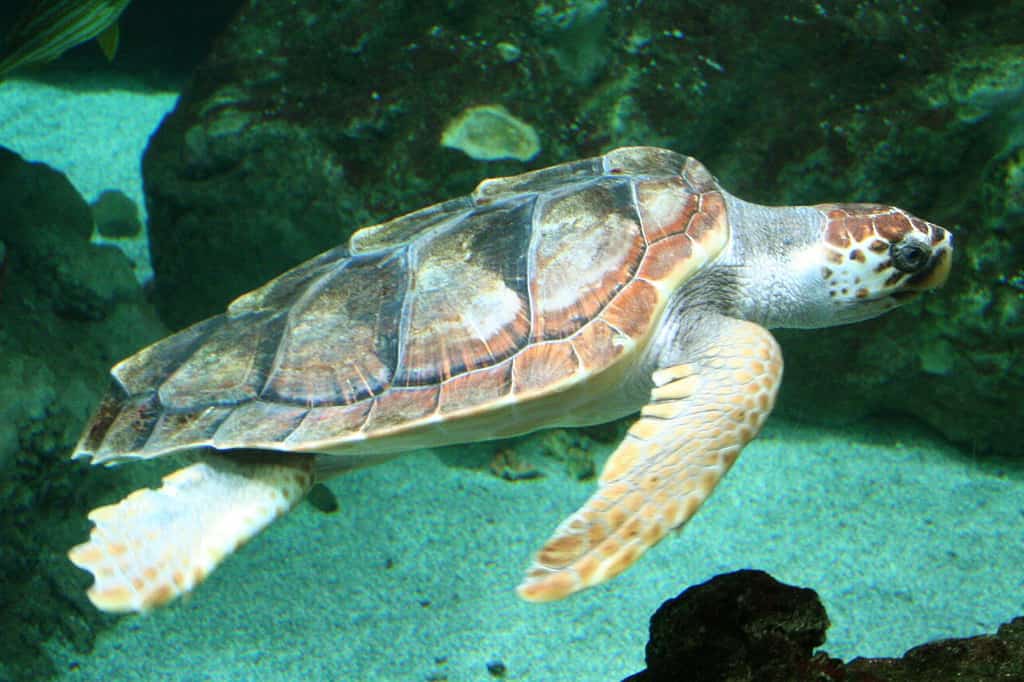
The Strait of Gibraltar serves as a migratory channel for loggerhead sea turtles.
Atlantic Sawtail Catshark (Galeus atlanticus)
The Strait of Gibraltar and surrounding waters serve as the home for a lesser-known species of shark, the Atlantic sawtail catshark (Galeus atlanticus). These sharks inhabit the demersal zone. This means they primarily hunt and live in a region of the water column just above the ocean floor. In the Strait of Gibraltar, the Atlantic sawtail catshark lives at depths of 900-2,100 feet. They primarily feed on small bony fish and crustaceans.
These small, demersal sharks grow only up to about 18 inches long. This slender species of catshark features large eyes and chestnut-brown splotching along its head, topline, sides, and fins. The estimated lifespan of this little-known species is about 10 years. However, this estimation could change as scientists understand more about this elusive shark.

The elusive, demersal Atlantic sawtail catshark lives in a limited range that primarily includes the Strait of Gibraltar.
What Lives in the Strait of Gibraltar: Barrel Jellyfish (Rhizostoma pulmo)
The spectacular-looking barrel jellyfish (Rhizostoma pulmo) occurs in temperate and subtropical waters. These waters include the northeastern Atlantic Ocean, Adriatic Sea, Mediterranean Sea, Black Sea, Sea of Azov, and the Strait of Gibraltar. This large, translucent jellyfish features a prominent mushroom-shaped dome. It has eight, prominent arms upon which tiny, frilly stinging tentacles are attached. While their mild venom can stun their diet of zooplankton and tiny fish, it does not represent much of a threat to people.
While the dome of the barrel jellyfish (aka the bell) typically grows up to 16 inches in diameter, it can occasionally reach up to 60 inches across. The overall length of this species reaches about 36 inches on average. However, some massive specimens can reach about 108 inches in length. Short-lived, the barrel jellyfish has an average lifespan of about 4-6 months. They are most abundant in shallow waters of the Strait of Gibraltar during warm months.
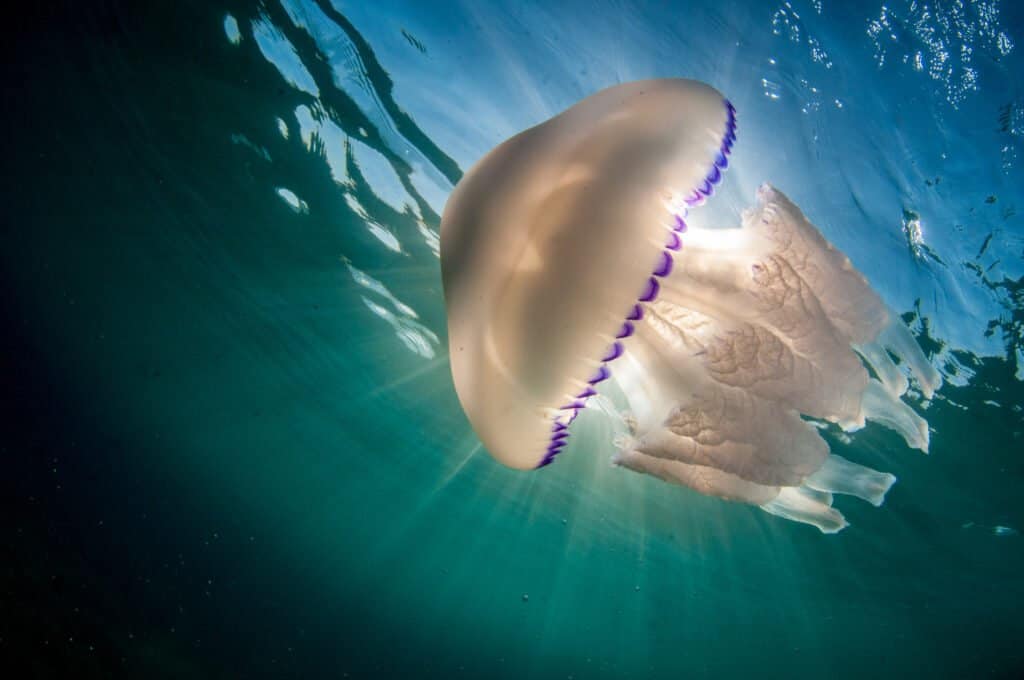
The stunning barrel jellyfish occurs in the Strait of Gibraltar and poses little threat to humans with its mildly venomous tentacles.
©iStock.com/Lophius
Atlantic Bluefin Tuna (Thunnus thynnus)
Throughout the majority of the year, the Strait of Gibraltar is home to adult and juvenile Atlantic bluefin tuna (Thunnus thynnus). These impressive fish routinely migrate through the Strait of Gibraltar. They move between their primary feeding grounds in the Atlantic Ocean and their spawning grounds in the Mediterranean Sea.
The Atlantic bluefin tuna feature streamlined, torpedo-like bodies that make them highly efficient and swift predators. The largest of tuna species, the Atlantic bluefin can reach up to 13 feet in length and weigh up to 2,000 pounds. In the Strait of Gibraltar, subadults feed primarily on crustaceans, especially shrimp. Adults feed on pelagic baitfish such as the Atlantic herring and Atlantic chub mackerel.
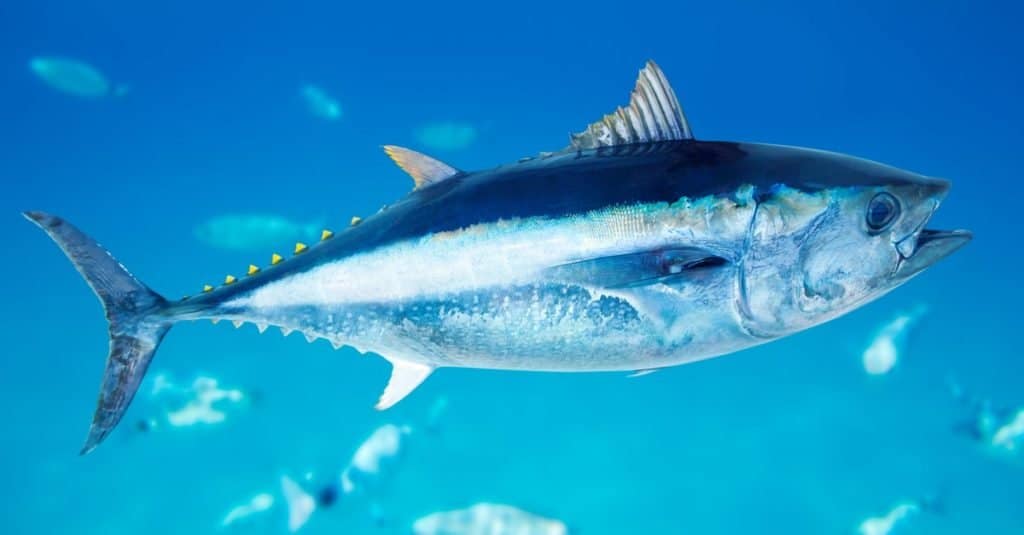
The Atlantic bluefin tuna is the largest of all tuna species, capable of reaching 13 feet in length.
©lunamarina/Shutterstock.com
Swimming in the Strait of Gibraltar: Is It Safe?
Strong currents and commercial and recreational vessels present in some areas of the Strait of Gibraltar represent the greatest threats to the safety of swimmers. However, experienced swimmers from across the globe do travel to this region to cross the strait and complete a cross-continent challenge. Visitors who wish to swim out beyond normal beach recreation should have strong swimming and water-treading skills.
For those seeking a more relaxed swimming experience, it’s best to visit some of the stunning beaches that dot the coastline of the strait such as in Tarifa, Spain, or Eddalya, Morocco.
The photo featured at the top of this post is © Javier Garcia Seijas/iStock via Getty Images
Thank you for reading! Have some feedback for us? Contact the AZ Animals editorial team.







